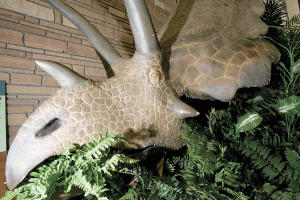A Pennsylvanian paleontologist has his eye on a nearby dinosaur that may answer hotly debated questions within the paleontology community.
Robert Sullivan, senior curator for the State Museum of Pennsylvania in Harrisburg, is seeking permits along with the New Mexico Museum of Natural History and Science to excavate what may be a complete fossil of a juvenile Pentaceratops from the Bisti/De-Na-Zin Wilderness area.The Bureau of Land Management says the excavation permits are likely to be completed soon and the project could begin this summer or fall, said Sherrie Landon, the paleontology coordinator for the BLM’s Farmington Field Office.
A Pentaceratops is a horned-face dinosaur with a large bony frill protruding above its head. It looks similar to the better-known triceratops but with a different horn pattern.The animal roamed the San Juan Basin 75 million years ago when the area was a plush, tropical rain forest, Landon said.
Only two complete Pentaceratops have been found. Both were collected in the San Juan Basin.Landon said the BLM in Farmington has seen a recent increase in museums interested in obtaining permits for searching and excavating fossils on federal land in the San Juan Basin.
“I think they are looking at the San Juan Basin because there hasn’t been a lot of recent excavations,” she said. “I think you’re going to see it continue to increase here in the next few years.”
In addition to having unique fossils here, the soft mud stone and sandstone of the landscape makes it easier to dig, she said.”We’re lucky Mother Nature has stripped these areas of their sediment and exposed all this,” Landon said. “There’s so many people who don’t know what’s in their backyard.”
Remains of the Pentaceratops and the duck-billed Hadrosaurid dinosaur are only found near Farmington because different excavation sites reveal fossils unique to certain time periods, Sullivan said.
A undergraduate student at the University of New Mexico discovered the juvenile Pentaceratops fossil last summer while on a class trip to the Bisti, said Spencer Lucas, the curator of geology and paleontology at the New Mexico Museum of Natural History and Science.Parts of the animal’s skull, spine and legs are protruding from a hill near a stream channel. It appears much of the fossil is still intact, Lucas said.
The first full Pentaceratops fossil was found in the 1920s and is kept at Uppsala University in Sweden. The second was found in the 1940s and is at the University of Oklahoma in Norman, Okla., Sullivan said.The Pentaceratops buried in the wilderness area will stay in New Mexico at the natural history museum, which is funding the project.
“It’s an incredibly important discovery because no one has ever seen a juvenile Pentaceratops before,” Lucas said.
Researchers who study horned dinosaurs long have debated the purpose of the large frills about their head and how they change as the animals mature. The fossil in the Bisti may shed light on that debate, Lucas said.
Tom Cunningham, the exhibit curator for the Farmington Museum at Gateway Park, said the local museum has started preliminary plans for an early-life exhibit that will feature the Pentaceratops. Sullivan and Lucas said they hope to have the dinosaur excavated before the end of the year. The remains will go to Albuquerque, where they will be cleaned and repaired.It will likely be about two years before the fossil can be displayed in a museum, Lucas said.
The natural history museum and the Farmington museum said it will be possible to arrange an agreement so the fossil can displayed in Farmington at some point.
“We’re hoping to get something,” Cunningham said. “I think it would a big draw. It would be significant for our museum.”



 May 29th, 2012
May 29th, 2012  riffin
riffin 
 Posted in
Posted in 